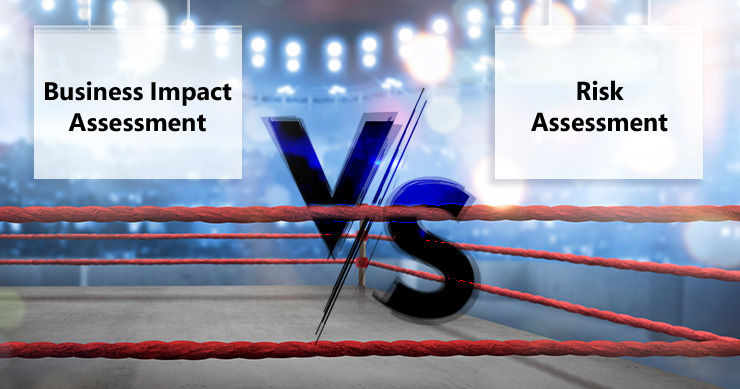While they may sound similar at first, a business impact analysis and a risk assessment assess the effects of potential cyber events from two totally different perspectives. Both are necessary to ensure operational resilience, business continuity, and disaster recovery, yet their approaches and purpose are vastly different. Understanding the difference will help you to reap maximum benefit from both!
Table of Contents
ToggleWhat is a Business Impact Analysis (BIA)?
Undertaking a business impact analysis allows a company to identify its critical business functions and consider what the consequences would be should they be disrupted in any way. Most importantly, a company can then take all that information and plan strategies to recover from disruptions, ensure business continuity and even predict downtime and recovery time.
What is a cyber Risk Assessment (RA)?
A cyber risk assessment proactively identifies situations and vulnerabilities that may lead to or cause a cyber incident, in contrast to the business impact analysis, which provides a view of an incident’s consequences. Situations and vulnerabilities that companies could identify may include accidental data leaks, hardware failure, misconfigured software, natural disasters, and ransomware.
How does a business impact analysis work?
A business impact analysis is often based on two assumptions. First of all, each section of your firm has interdependencies. They depend on the other segments’ continuous operation for their own continuous operation.
Secondly, some resources or elements of the business will be more important than others in the case of a disruption. Not everything is critical, but it’s obviously very important to identify what is! If the coffee machine breaks, the business can continue to operate (albeit with some grumpy employees), but if the main computer network goes down or the data center is held to ransomware, business operations will come to a halt.
When assessing the financial or operational impact of an incident, you’ll need to identify the following:
- Lost sales opportunities
- Overdue or delayed income
- Equipment damage or breakdown
- Supply chain interruption
- Overhead costs, such as overtime for your IT department
- Regulatory fines(i.e., HIPAA)
- Legal fees
- Losses associated with contracts
- Customer dissatisfaction
- Business strategy disruption
- The timing of an incident, e.g., during downtime or in the middle of a busy season.
After identifying the above considerations, you can determine the scope of the incident, understand the finances involved, and know what you need to prepare for. Your next step is to decide the following:
- The resources needed to ensure operational resilience should the incident occur.
- The threshold for time to recover.
- The threshold for downtime during recovery.
- The level and nature of acceptable data loss.
The scope and focus of the above may vary according to your industry, the type of business, and the size. Your industry, for example, determines the regulatory frameworks to which you must adhere, and these vary greatly in the level of effort and investment it takes to adhere to them. As every business has a unique ecosystem, each company will approach these considerations differently. For example, companies that work with multiple vendors or complex supply chains will require a different approach than one that’s largely self-contained.
Which best practices help achieve effective Business Impact Analysis and Risk Assessments?
- Consider employing an industry-standard framework. ISO 22301 is one of the most common and includes risk assessment and mitigation guidance.
- Successful risk management starts from the top. Ensure you have leadership buy-in by keeping the Executive Level informed in a way they can understand.
- Collaborate across departments from the start to ensure you have an accurate view of the big picture.
- Keep detailed loggings of conversations and meetings.
- Be aware of the differences between objective and subjective criteria.
- Remember that business impact analysis is a means to a larger business objective.
- Ensure your business impact analysis tools have the necessary functionality and analytics capabilities.
- Remember that risk assessment should be part of a broader risk management program.
- Understand the key objectives of your risk management program.
- Use analytical tools to check that the risk data you generate is as accurate and informative as possible.
- Risk management is an organization-wide initiative and should foster a risk-minded culture in your company.
- The goals and targets of your risk management program should align with your business objectives.
- Risk management, assessment, and mitigation strategies should be standardized and consistent.
Back to the beginning: So what is the difference between a business impact analysis and a risk assessment?
There is a lot of overlap between these two processes, as you might have understood by now. The placement of each in your disaster recovery plan is where the biggest distinction between the two may be found. Put another way, a risk assessment considers what might occur, but an impact assessment considers what has already occurred.
Risk analyses are typical of a proactive character. To lessen the potential harm each risk could do to the company, they try to measure and mitigate it. The ultimate objective is to lessen the likelihood that a cyber event will happen.
A business impact study investigates what will happen to the organization if an incident does occur. It assesses each unaddressed risk that was discovered during your risk assessment. It then makes an effort to forecast what may happen if a specific risk materializes while making sure that your company has the essential systems, procedures, and resources in place for continuity.
This all may sound quite similar to the third step of the risk assessment process, and that comes as no surprise. An impact assessment expands on the quantification stage of a risk assessment. For all their differences, the risk assessment and business impact analysis are intertwined and complementary processes.
The Centraleyes Solution for BIA and Risk Assessment
Every organization should dedicate time and resources to understand better the risks their organization faces. Awareness is the first step to taking action. Facing up to the risks may feel overwhelming or pessimistic, but it is really just vitally good business sense. No business wants to be caught unaware, so ensure you have the necessary recovery and business continuity plans in place. Forewarned is forearmed!
Centraleyes makes it easy for you to pinpoint the most technical of cyber risks and translate that into business risks. With Centraleyes, you can identify both the financial and overall business impact of that risk and automate the remediation planning process to achieve more visibility and execution when it comes to mitigating risk. Our automated reporting feature generates reports that can be understood by tech teams and executive levels alike for better communication and informed decision-making.





